sensor MITSUBISHI OUTLANDER PHEV 2017 (in English) Owner's Guide
[x] Cancel search | Manufacturer: MITSUBISHI, Model Year: 2017, Model line: OUTLANDER PHEV, Model: MITSUBISHI OUTLANDER PHEV 2017Pages: 548, PDF Size: 25.5 MB
Page 206 of 548
![MITSUBISHI OUTLANDER PHEV 2017 (in English) Owners Guide [When the sensor is malfunctioning]
NOTElIf the sensor or its surrounding area reaches
an extremely high temperature when parking the vehicle under a blazing sun, the “AHBSERVICE REQU MITSUBISHI OUTLANDER PHEV 2017 (in English) Owners Guide [When the sensor is malfunctioning]
NOTElIf the sensor or its surrounding area reaches
an extremely high temperature when parking the vehicle under a blazing sun, the “AHBSERVICE REQU](/img/19/34889/w960_34889-205.png)
[When the sensor is malfunctioning]
NOTElIf the sensor or its surrounding area reaches
an extremely high temperature when parking the vehicle under a blazing sun, the “AHBSERVICE REQUIRED” warning display
may appear.
If the warning display remains even after the temperature of the sensor or its surrounding area has been in range, please contact a
MITSUBISHI MOTORS Authorized Serv-
ice Point.
Sensor is too hot or cold
If the system becomes temporarily unavaila-
ble due to a high or low temperature of thesensor, the following warning display will
appear.
After the temperature of the sensor has been
in range, the system will automatically return
to operation.
If the warning display does not disappear af- ter waiting for a while, there is a possibilitythat the automatic high-beam system has a
malfunction. Contact a MITSUBISHI
MOTORS Authorized Service Point for in-
spection of the system.
Windscreen is dirty
If the automatic high-beam system deter- mines that its performance has been degra-ded, the warning display will appear.
This can occur when:
l Foreign objects, such as dirt, snow or
ice, adhere to the windscreen of the sen-
sor portion.
l There are adverse weather conditions,
such as rain, snow, sand storms, etc.
l A vehicle in front or an oncoming vehi-
cle is splashing water, snow or dirt.
When the sensor performance returns, the au-
tomatic high-beam system will resume opera- tion.
If the warning display does not disappear af-
ter waiting for a while, there is a possibility that the sensor has a malfunction. Contact a MITSUBISHI MOTORS Authorized Service
Point for inspection of the sensor.Welcome light
E00528902072
This function turns on the position and tail
lamps for about 30 seconds after the UN- LOCK switch on the remote control transmit-
ter is pressed when the combination head-
lamps and dipper switch is in the “OFF” or
“AUTO” position. The welcome light func- tion will operate only when it is dark outside
the vehicle.
NOTEl While the welcome light function is operat-
ing, perform one of the following operations to cancel the function.
• Push the LOCK switch on the remote
control transmitter.
• Turn the combination headlamps and dip-
per switch to the “
” or “” position.
Combination headlamps and dipper switch
6-59OGGE17E1Instruments and controls6
Page 211 of 548

Turn the knob once in the “ON” direction to
turn on the front fog lamps. Turn the knob once more in the “ON” direction to turn on
the rear fog lamp. To turn the rear fog lamp off, turn the knob once in the “OFF” direc- tion. Turn the knob once more in the “OFF”
direction to turn off the front fog lamps. The
knob will automatically return to its original
position when you release it.NOTEl The rear fog lamp is automatically turned off
when the headlamps or front fog lamps are
turned off.
l To turn the rear fog lamp on again, turn the
knob twice in the “ON” direction after turn- ing on the headlamps.Wiper and washer switch
E00507101218CAUTIONlIf the washer is used in cold weather, the
washer fluid sprayed against the glass may
freeze, which may hinder visibility. Warm the glass with the defroster or rear window
demister before using the washer.Windscreen wipers
E00516901980NOTEl To ensure a clear rearward view, the rear
window wiper will automatically perform several continuous operations if the selector lever is put in the “R” position while the
windscreen wipers are operating.
Refer to “Rear window wiper and washer” on page 6-67.
The windscreen wipers can be operated with
the operation mode of the power switch in ON or ACC.
If the blades are frozen to the windscreen or
rear window, do not operate the wipers until the ice has melted and the blades are freed,
otherwise the wiper motor may be damaged.MIST-Misting function
The wipers will operate once.OFF-OffAUTO-Auto-wiper control
Rain sensor
The wipers will automatically
operate depending on the degree
of wetness on the windscreen.LO-SlowHI-Fast
Rain sensor
Can only be used when the ignition switch or the operation mode is in ON.
Wiper and washer switch
6-64OGGE17E1Instruments and controls6
Page 212 of 548

If the lever is put in the “AUTO” position,the rain sensor (A) will detect the extent of
rain (or snow, other moisture, dust, etc.) and the wipers will operate automatically.
Keep the lever in the “OFF” position if the windscreen is dirty and the weather is dry.
Wiper operation under these conditions can scratch the windscreen and damage the wip-
ers.CAUTIONl With the ignition switch or the operation
mode in ON and the lever in the “AUTO”
position, the wipers may automatically oper-
ate in the situations described below.
If your hands get trapped, you could suffer injuries or the wipers could malfunction. Be sure to turn the ignition switch to the
“LOCK” position or put the operation mode
in OFF, or move lever to the “OFF” position to deactivate the rain sensor.CAUTION• When cleaning the outside surface of the
windscreen, if you touch on top of the
rain sensor.
• When cleaning the outside surface of the
windscreen, if you wipe with a cloth on
top of the rain sensor.
• When using an automatic car wash.
• A physical shock is applied to the wind-
screen.
• A physical shock is applied to the rain
sensor.NOTEl To protect the rubber parts of the wipers,
this operation of the wipers does not take
place even if the lever is put in the “AUTO” position when the vehicle is stationary and
the ambient temperature is about 0 °C or lower.
l Do not cover the sensor by affixing a sticker
or label to the windscreen. Also, do not put any water-repellent coating on the wind-screen. The rain sensor would not be able to
detect the extent of rain, and the wipers
might stop working normally.
l In the following cases, the rain sensor may
be malfunctioning.
For further information, we recommend you
to consult a MITSUBISHI MOTORS Au-
thorized Service Point.
• When the wipers operate at a constant in-
terval despite changes in the extent of
rain.NOTE• When the wipers do not operate even
though it is raining.
l The wipers may automatically operate when
things such as insects or foreign objects are affixed to the windscreen on top of the rainsensor or when the windscreen is frozen.
Objects affixed to the windscreen will stop
the wipers when the wipers cannot remove them. To operate the wipers again, move the
lever in the “LO” or “HI” position.
Also, the wipers may operate automatically due to strong direct sunlight or electromag-
netic wave. To stop the wipers, place the lever in the “OFF” position.
l Contact a
MITSUBISHI MOTORS Author-
ized Service Point when replacing the wind- screen or reinforcing the glass around the
sensor.
Wiper and washer switch
6-65OGGE17E1Instruments and controls6
Page 213 of 548

To adjust the sensitivity of therain sensor
With the lever in the “AUTO” (rain sensor) position, it is possible to adjust the sensitivityof the rain sensor by turning the knob (B).
“+”- Higher sensitivity to rain
“-”- Lower sensitivity to rain
NOTEl It is possible to activate the following func-
tions.
• Automatic operation (rain droplet sensi-
tive) can be changed to intermittent opera-
tion (vehicle-speed sensitive).
• Automatic operation (rain droplet sensi-
tive) can be changed to intermittent opera-
tion (except vehicle-speed sensitive).
For further information, we recommend you to consult a MITSUBISHI MOTORS Au-
thorized Service Point.NOTEOn vehicles equipped with the Smartphone
Link Display Audio or the MITSUBISHI
Multi-Communication System (MMCS), screen operations can be used to make theadjustment. Refer to the separate owner’s
manual for details.
Misting function
Move the lever in the direction of the arrow
and release, to operate the wipers once.
Use this function when you are driving in
mist or drizzle.
The wipers will operate once if the lever is raised to the “MIST” position and released
when the ignition switch or the operation
mode is in the “ON” or “ACC” position. The wipers will continue to operate while the lev- er is held in the “MIST” position.
The wipers will operate once if the lever is
moved to the “AUTO” position and the knob
(C) is turned in the “+” direction when the ig- nition switch is in the “ON” position.Windscreen washer
E00507202607
The windscreen washer can be operated with the operation mode of the power switch in
ON or ACC.
The washer fluid will be sprayed onto the windscreen by pulling the lever towards you.When the wipers are not in operation or in in-
termittent operation, by pulling the lever to-
wards you, the wipers will operate several
times while the washer fluid is being sprayed. Except for vehicles for Russia, Kazakhstan
and Ukraine, then about 6 seconds later, wip- ers operate once more.
Wiper and washer switch
6-66OGGE17E1Instruments and controls6
Page 220 of 548
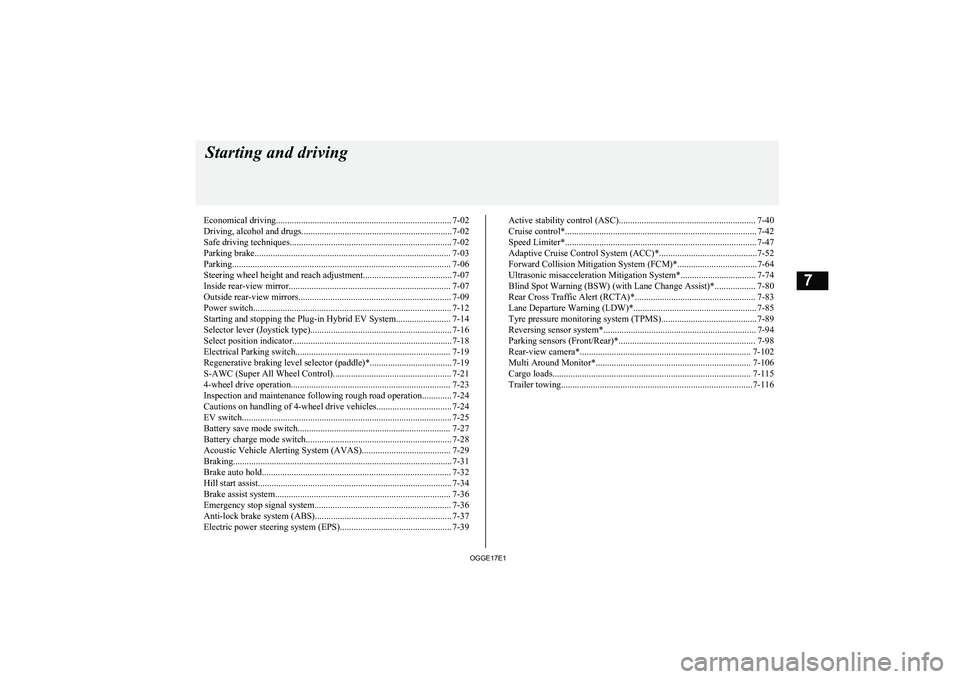
Economical driving............................................................................. 7-02
Driving, alcohol and drugs
.................................................................. 7-02
Safe driving techniques....................................................................... 7-02
Parking brake...................................................................................... 7-03
Parking................................................................................................ 7-06
Steering wheel height and reach adjustment....................................... 7-07
Inside rear-view mirror....................................................................... 7-07
Outside rear-view mirrors................................................................... 7-09
Power switch....................................................................................... 7-12
Starting and stopping the Plug-in Hybrid EV System........................ 7-14
Selector lever (Joystick type).............................................................. 7-16
Select position indicator...................................................................... 7-18
Electrical Parking switch.................................................................... 7-19
Regenerative braking level selector (paddle)*.................................... 7-19
S-AWC (Super All Wheel Control).................................................... 7-21
4-wheel drive operation...................................................................... 7-23
Inspection and maintenance following rough road operation............. 7-24
Cautions on handling of 4-wheel drive vehicles................................. 7-24
EV switch............................................................................................ 7-25
Battery save mode switch................................................................... 7-27
Battery charge mode switch................................................................ 7-28
Acoustic Vehicle Alerting System (AVAS)....................................... 7-29
Braking................................................................................................ 7-31
Brake auto hold................................................................................... 7-32
Hill start assist..................................................................................... 7-34
Brake assist system............................................................................. 7-36
Emergency stop signal system............................................................ 7-36
Anti-lock brake system (ABS)............................................................ 7-37
Electric power steering system (EPS)................................................. 7-39 Active stability control (ASC)............................................................ 7-40
Cruise control* .................................................................................... 7-42
Speed Limiter*.................................................................................... 7-47
Adaptive Cruise Control System (ACC)*...........................................7-52
Forward Collision Mitigation System (FCM)*...................................7-64
Ultrasonic misacceleration Mitigation System*................................. 7-74
Blind Spot Warning (BSW) (with Lane Change Assist)*.................. 7-80
Rear Cross Traffic Alert (RCTA)*..................................................... 7-83
Lane Departure Warning (LDW)*...................................................... 7-85
Tyre pressure monitoring system (TPMS).......................................... 7-89
Reversing sensor system*................................................................... 7-94
Parking sensors (Front/Rear)*............................................................ 7-98
Rear-view camera*........................................................................... 7-102
Multi Around Monitor*.................................................................... 7-106
Cargo loads....................................................................................... 7-115
Trailer towing....................................................................................7-116 Starting and driving
OGGE17E1 7
Page 228 of 548
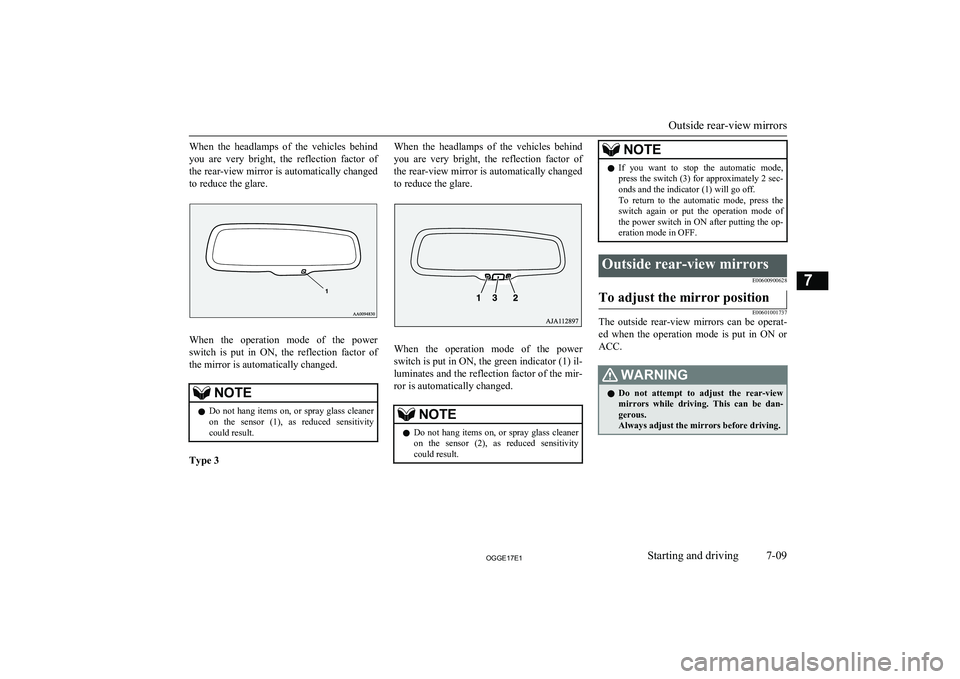
When the headlamps of the vehicles behindyou are very bright, the reflection factor ofthe rear-view mirror is automatically changed
to reduce the glare.
When the operation mode of the power
switch is put in ON, the reflection factor of the mirror is automatically changed.
NOTEl Do not hang items on, or spray glass cleaner
on the sensor (1), as reduced sensitivitycould result.
Type 3
When the headlamps of the vehicles behind
you are very bright, the reflection factor ofthe rear-view mirror is automatically changed
to reduce the glare.
When the operation mode of the power
switch is put in ON, the green indicator (1) il- luminates and the reflection factor of the mir-ror is automatically changed.
NOTEl Do not hang items on, or spray glass cleaner
on the sensor (2), as reduced sensitivitycould result.NOTEl If you want to stop the automatic mode,
press the switch (3) for approximately 2 sec- onds and the indicator (1) will go off.
To return to the automatic mode, press the
switch again or put the operation mode of the power switch in ON after putting the op- eration mode in OFF.Outside rear-view mirrors
E00600900628To adjust the mirror position
E00601001737
The outside rear-view mirrors can be operat-
ed when the operation mode is put in ON or ACC.
WARNINGl Do not attempt to adjust the rear-view
mirrors while driving. This can be dan-
gerous.
Always adjust the mirrors before driving.
Outside rear-view mirrors
7-09OGGE17E1Starting and driving7
Page 258 of 548
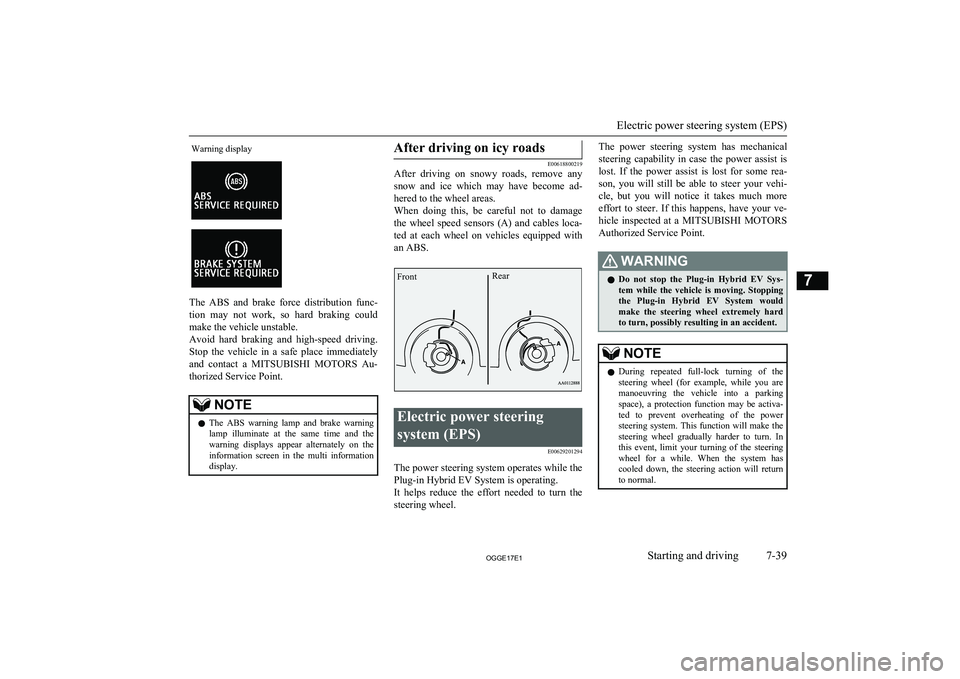
Warning display
The ABS and brake force distribution func-tion may not work, so hard braking could
make the vehicle unstable.
Avoid hard braking and high-speed driving.
Stop the vehicle in a safe place immediately
and contact a MITSUBISHI MOTORS Au-
thorized Service Point.
NOTEl The ABS warning lamp and brake warning
lamp illuminate at the same time and the
warning displays appear alternately on the information screen in the multi informationdisplay.After driving on icy roads
E00618800219
After driving on snowy roads, remove any
snow and ice which may have become ad-
hered to the wheel areas.
When doing this, be careful not to damage the wheel speed sensors (A) and cables loca-ted at each wheel on vehicles equipped with an ABS.
Electric power steering
system (EPS) E00629201294
The power steering system operates while thePlug-in Hybrid EV System is operating.
It helps reduce the effort needed to turn the steering wheel.
The power steering system has mechanical
steering capability in case the power assist is lost. If the power assist is lost for some rea-
son, you will still be able to steer your vehi-
cle, but you will notice it takes much more
effort to steer. If this happens, have your ve- hicle inspected at a MITSUBISHI MOTORS
Authorized Service Point.WARNINGl Do not stop the Plug-in Hybrid EV Sys-
tem while the vehicle is moving. Stopping the Plug-in Hybrid EV System would
make the steering wheel extremely hard to turn, possibly resulting in an accident.NOTEl During repeated full-lock turning of the
steering wheel (for example, while you are manoeuvring the vehicle into a parking space), a protection function may be activa-
ted to prevent overheating of the power steering system. This function will make the
steering wheel gradually harder to turn. In
this event, limit your turning of the steering wheel for a while. When the system has
cooled down, the steering action will return to normal.
Electric power steering system (EPS)
7-39OGGE17E1Starting and driving7 FrontRear
Page 271 of 548
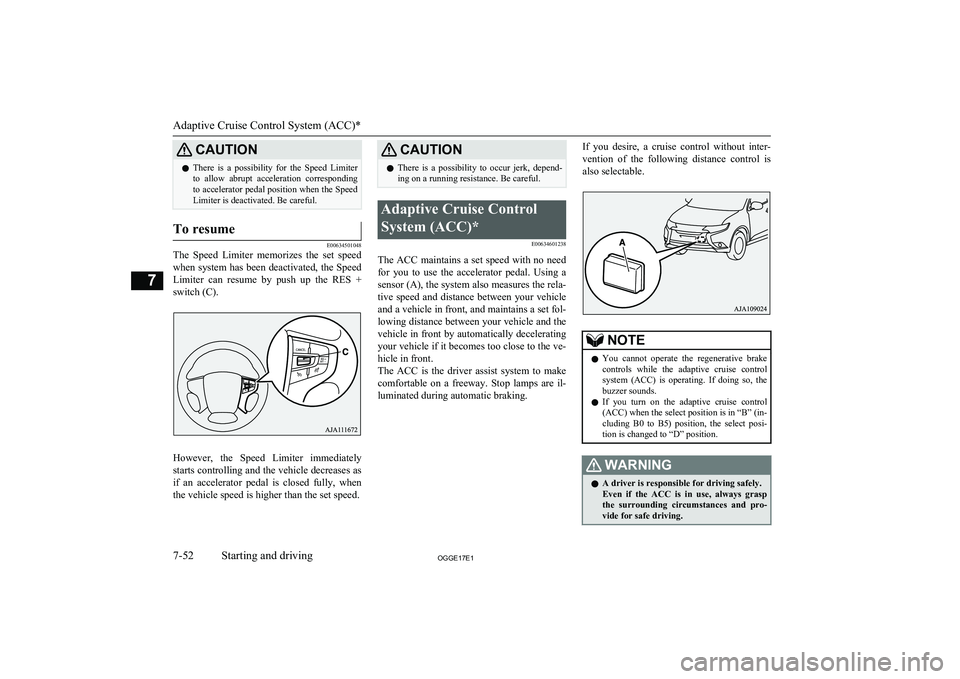
CAUTIONlThere is a possibility for the Speed Limiter
to allow abrupt acceleration corresponding
to accelerator pedal position when the Speed Limiter is deactivated. Be careful.To resume
E00634501048
The Speed Limiter memorizes the set speed
when system has been deactivated, the Speed
Limiter can resume by push up the RES +
switch (C).
However, the Speed Limiter immediately
starts controlling and the vehicle decreases as if an accelerator pedal is closed fully, whenthe vehicle speed is higher than the set speed.
CAUTIONl There is a possibility to occur jerk, depend-
ing on a running resistance. Be careful.Adaptive Cruise Control
System (ACC)* E00634601238
The ACC maintains a set speed with no needfor you to use the accelerator pedal. Using a
sensor (A), the system also measures the rela- tive speed and distance between your vehicle
and a vehicle in front, and maintains a set fol- lowing distance between your vehicle and thevehicle in front by automatically decelerating
your vehicle if it becomes too close to the ve-
hicle in front.
The ACC is the driver assist system to make comfortable on a freeway. Stop lamps are il-luminated during automatic braking.
If you desire, a cruise control without inter-
vention of the following distance control is
also selectable.NOTEl You cannot operate the regenerative brake
controls while the adaptive cruise control
system (ACC) is operating. If doing so, the
buzzer sounds.
l If you turn on the adaptive cruise control
(ACC) when the select position is in “B” (in-
cluding B0 to B5) position, the select posi-
tion is changed to “D” position.WARNINGl A driver is responsible for driving safely.
Even if the ACC is in use, always grasp the surrounding circumstances and pro- vide for safe driving.
Adaptive Cruise Control System (ACC)*
7-52OGGE17E1Starting and driving7
Page 272 of 548
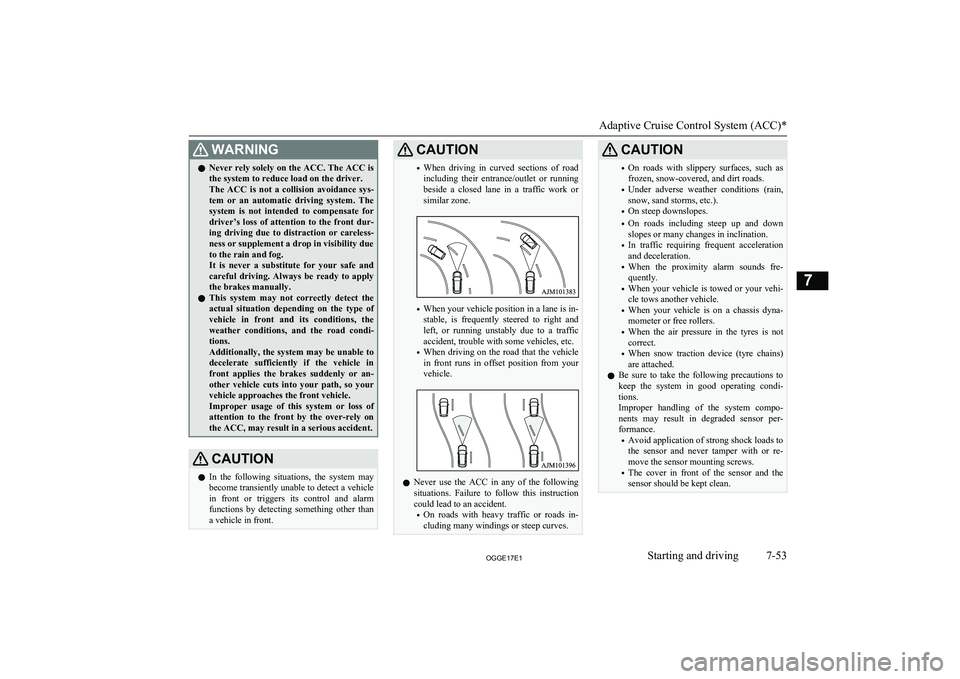
WARNINGlNever rely solely on the ACC. The ACC is
the system to reduce load on the driver.
The ACC is not a collision avoidance sys-
tem or an automatic driving system. The system is not intended to compensate for
driver’s loss of attention to the front dur-
ing driving due to distraction or careless-
ness or supplement a drop in visibility due
to the rain and fog.
It is never a substitute for your safe and careful driving. Always be ready to applythe brakes manually.
l This system may not correctly detect the
actual situation depending on the type of vehicle in front and its conditions, theweather conditions, and the road condi-
tions.
Additionally, the system may be unable to
decelerate sufficiently if the vehicle in front applies the brakes suddenly or an- other vehicle cuts into your path, so yourvehicle approaches the front vehicle.Improper usage of this system or loss of
attention to the front by the over-rely on the ACC, may result in a serious accident.CAUTIONl In the following situations, the system may
become transiently unable to detect a vehicle in front or triggers its control and alarm
functions by detecting something other than a vehicle in front.CAUTION• When driving in curved sections of road
including their entrance/outlet or running beside a closed lane in a traffic work or
similar zone.
• When your vehicle position in a lane is in-
stable, is frequently steered to right and left, or running unstably due to a trafficaccident, trouble with some vehicles, etc.
• When driving on the road that the vehicle
in front runs in offset position from your
vehicle.
l Never use the ACC in any of the following
situations. Failure to follow this instructioncould lead to an accident.
• On roads with heavy traffic or roads in-
cluding many windings or steep curves.
CAUTION• On roads with slippery surfaces, such as
frozen, snow-covered, and dirt roads.
• Under adverse weather conditions (rain,
snow, sand storms, etc.).
• On steep downslopes.
• On roads including steep up and down
slopes or many changes in inclination.
• In traffic requiring frequent acceleration
and deceleration.
• When the proximity alarm sounds fre-
quently.
• When your vehicle is towed or your vehi-
cle tows another vehicle.
• When your vehicle is on a chassis dyna-
mometer or free rollers.
• When the air pressure in the tyres is not
correct.
• When snow traction device (tyre chains)
are attached.
l Be sure to take the following precautions to
keep the system in good operating condi-
tions.
Improper handling of the system compo-
nents may result in degraded sensor per- formance.
• Avoid application of strong shock loads to
the sensor and never tamper with or re- move the sensor mounting screws.
• The cover in front of the sensor and the
sensor should be kept clean.
Adaptive Cruise Control System (ACC)*
7-53OGGE17E1Starting and driving7
Page 273 of 548
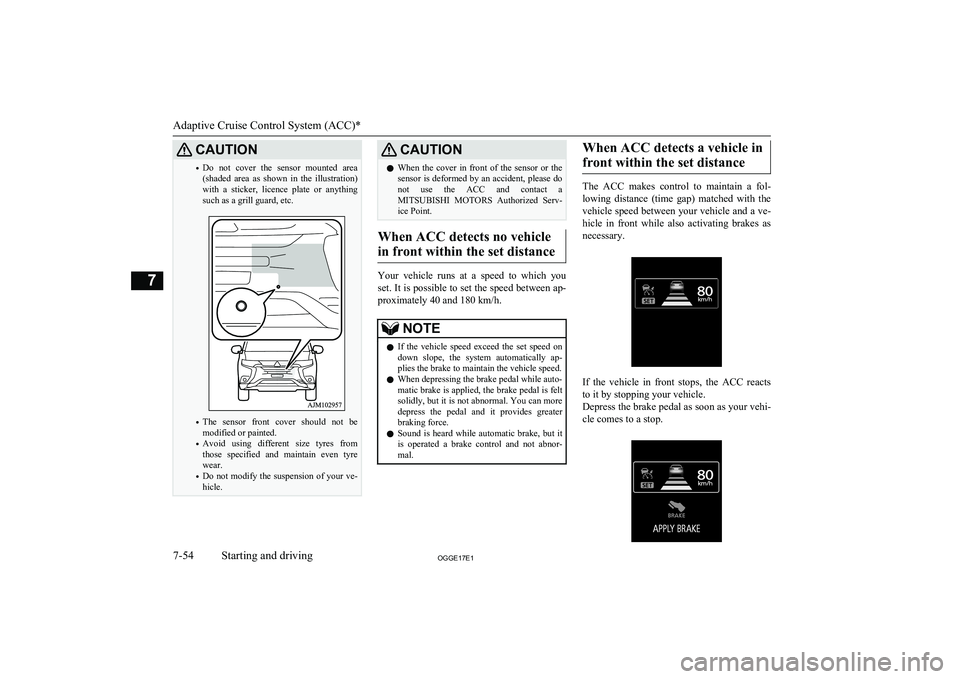
CAUTION•Do not cover the sensor mounted area
(shaded area as shown in the illustration)
with a sticker, licence plate or anything
such as a grill guard, etc.
• The sensor front cover should not be
modified or painted.
• Avoid using different size tyres from
those specified and maintain even tyre
wear.
• Do not modify the suspension of your ve-
hicle.
CAUTIONl When the cover in front of the sensor or the
sensor is deformed by an accident, please do
not use the ACC and contact a
MITSUBISHI MOTORS Authorized Serv-
ice Point.
When ACC detects no vehicle
in front within the set distance
Your vehicle runs at a speed to which you set. It is possible to set the speed between ap-
proximately 40 and 180 km/h.
NOTEl If the vehicle speed exceed the set speed on
down slope, the system automatically ap-plies the brake to maintain the vehicle speed.
l When depressing the brake pedal while auto-
matic brake is applied, the brake pedal is felt solidly, but it is not abnormal. You can moredepress the pedal and it provides greater
braking force.
l Sound is heard while automatic brake, but it
is operated a brake control and not abnor-
mal.When ACC detects a vehicle in
front within the set distance
The ACC makes control to maintain a fol- lowing distance (time gap) matched with the vehicle speed between your vehicle and a ve-
hicle in front while also activating brakes as necessary.
If the vehicle in front stops, the ACC reacts
to it by stopping your vehicle.
Depress the brake pedal as soon as your vehi- cle comes to a stop.
Adaptive Cruise Control System (ACC)*
7-54OGGE17E1Starting and driving7